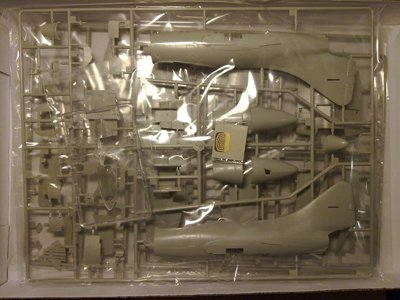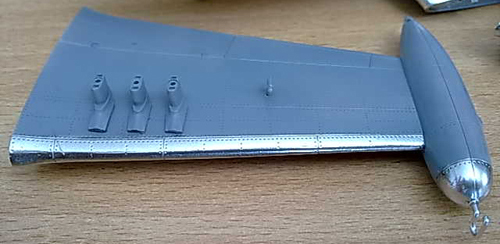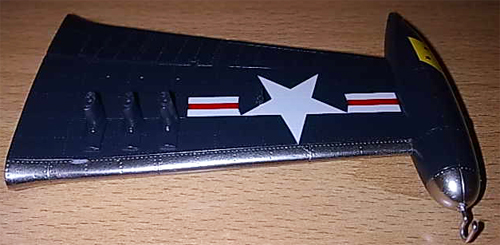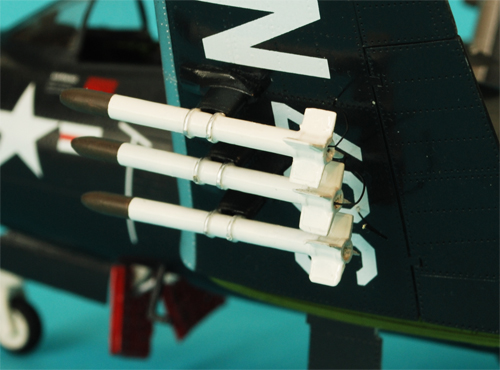.: Trumpeter F9F-2P "Panther"
 The first Panther flew on 24 november 1947. The thirsty aircraft didn't have enough internal space for fuel, so permanent wingtip tanks were mounted. The first carrier based flights took place in september 1947.
The first Panther flew on 24 november 1947. The thirsty aircraft didn't have enough internal space for fuel, so permanent wingtip tanks were mounted. The first carrier based flights took place in september 1947.
From 1946, a swept-wing version was considered and after concerns about the Panther's inferiority to its MiG opponents in Korea, a conversion of the Panther (Design 93) resulted in a swept-wing derivative of the Panther, the Grumman F9F Cougar, which retained the Panther's designation number.
The Panther served in the Korean War, mainly as an attack aircaft. Although the Panther was a relative slow aircraft, it mannaged to down two Yak-9s and five MiG-15s, with only one loss. The F9 served until 1956 on the front-line.
The F9 Panther plays a big role in Buck Danny comics,
that's where I noticed this wonderful aircraft for the first time.
.: The kit
 The F9F-2P, subject of this kit, was an unarmed photographic reconnaissance version used in Korea.
The F9F-2P, subject of this kit, was an unarmed photographic reconnaissance version used in Korea.
This is my first Trumpeter model. I have read a lot about and seen many models of Trumpeter. It seems that overall they produce good models, but now and than they make some big errors. I do not know how accurate this kit is, but I am intent to find.
Since I found the model on E-bay for a bargain I didn't have to much choice in the actual model of the Panther. In this case the Recce-version. Not really my first choice, but fine with me. Most surprising was the extra nose cone on a sprue that gives the possibility to make it a regular F9F-2 after all. This has one drawback, the kit's decals will be inaccurate. But there are enough aftermarket alternatives available. So I ordered a Superscale set for the F9F-2.
The kit's directions are straight forward and contains just a few steps. Not the complete booklets I was used to during the last models.

The Cockpit is nicely detailed, buttons and switches on the side panels are raised enough for painting and dry-brushing, and the PE-part for the instrument panel is a welcome extra. I only added some frame parts and wires on the inner fuselage and a throttle.
The ejection seat on the other hand is a bit simple, although de details are sharp. Something we see to often with models. Again I added some wires, and also the ejection handles, seatbelts and a cover on top of the seat.
The fuselage and the wings do fit very well, which was a bit of a surprise to me. I never thought this Trumpeter kit could be that good
... Until I attached the tail-planes... What ever I tried, A big seem kept appearing. The only solution is: filler. That was a disappointment...
And do not forget the extra weight in the nose. I added 30 grams.
.: Painting
 |
 |
First the model was sprayed with a layer of Model Masters grey primer. Only a few errors showed up and easily repaired. Then I masked everything but the leading edges and the air intakes. These were sprayed with a layer of gloss black, followed by a layer of Alclad II, Polished Aluminium (ALC-105). The paint was sealed with Future.
After the paint was dry I masked the leading edges and the air intakes and sprayed the rest of the model with Model Master Dark Sea Blue (1717), followed by another layer of Future.
.: Decals
The decals came from Superscale (48-1183). As always, Superscale decals are a joy to work with. Extremely thin and very sharp printed. During the process of decaling I lost one decal while preventing the cat from jumping on my bench. A few days later I found the decal on the floor and after a few seconds in water it went on the model like a charm!
.: Final assembly
 After all the parts were painted, the final assembly was easy. Main landing gear, canopy and folded wings.
After all the parts were painted, the final assembly was easy. Main landing gear, canopy and folded wings.
Weapons of choice were six HVAR 5in rockets, since Buck's Panther was also equipped with these rockets. With some extra work on the rocket's exhaust, wirering and the rocket's head they just look a little bit better.
.: Conclusion
This Trumpeter kit is a joy to work on and easy to build. If you like US Navy aircraft, and Panthers particularly, this model is a good choice. Finally, the option of the original kit's F9F-2P and the 'secret' bonus of a standard F-9F2 is a welcome one.